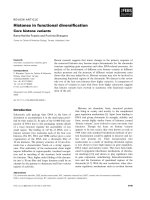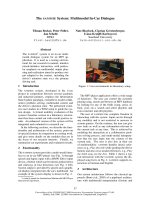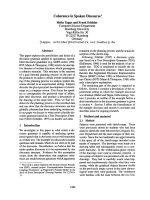Báo cáo khoa học: " Autopsy in critical illness: is it obsolete" pot
Bạn đang xem bản rút gọn của tài liệu. Xem và tải ngay bản đầy đủ của tài liệu tại đây (29.82 KB, 2 trang )
407
Available online />In the present issue of Critical Care, Perkins and colleagues
revisit the role of autopsy in critically ill patients [1]. These
authors evaluated 38 of 49 available autopsy reports in a
population of 636 patients (6%). They found that premortem
and postmortem findings were in complete agreement in less
than one-half of these cases and that major missed
diagnoses that might impact on treatment and outcome were
present in 39% of the cases reviewed. The most frequently
missed diagnoses included myocardial infarction, carcinoma
and pulmonary embolism.
Autopsy series continue to appear in the medical literature
and they continue to have an important clinical impact. The
present commentary will outline the limitations and
contributions of autopsy data. It will include a brief discussion
of selection bias in autopsy studies, the important role
autopsy plays in tracking disease prevalence over time, its
characterization of newly emerging diseases, its contribution
to education and quality control programs, and its role in
clinical decision-making.
Limitations of autopsy data
Autopsy studies are case series and they usually represent a
small proportion of the total number of patient deaths
recorded in the study period. Most often, the reader is not
given the total number of patient deaths, so the proportion of
patients undergoing autopsy and how representative that
study sample might be is never known. The Perkins and
colleagues’ study, however, gives the reader very complete
information [1]. They indicate that 7.7% of their deaths had
postmortem examinations and that their study sample
represented 6% of the total deaths. This proportion is small
and it is not valid to conclude that these results represent the
larger patient population. The authors point this out
themselves. That is not to say that these observations are
uninformative, but it does mean that most autopsy study data
suffer from selection bias and this has to be considered
when one discusses study results and their implications.
Role of autopsy in tracking disease
prevalence and in characterizing new disease
Findings on autopsy may reflect systematic shifts in the
prevalence of disease states over time and may serve to
highlight the limitations of current medical imaging and other
diagnostic procedures. In 1983, Goldman and colleagues
analyzed 100 randomly selected autopsies from each of the
academic years 1960, 1970 and 1980 at one university
teaching hospital [2]. In each of these three decades,
approximately 10% of autopsies revealed a diagnosis that
might have lead to a change in therapy or outcome had it
been known prior to the patient’s death. In the 1980 autopsy
series, there were fewer cases of renal disease and
pulmonary embolism but a dramatic increase in systemic
bacterial, viral and fungal infections. Renal disease became a
less prevalent cause of death because of the introduction of
long-term renal replacement therapy. Pulmonary embolus
Commentary
Autopsy in critical illness: is it obsolete?
Margaret S Herridge
Assistant Professor of Medicine, University of Toronto, Pulmonary and Critical Care, Toronto General Hospital, Toronto, Ontario, Canada
Correspondence: Margaret S Herridge,
Published online: 26 September 2003 Critical Care 2003, 7:407-408 (DOI 10.1186/cc2378)
This article is online at />© 2003 BioMed Central Ltd (Print ISSN 1364-8535; Online ISSN 1466-609X)
Abstract
The autopsy continues to have important implications for patient management in critical illness. It is not
obsolete. Autopsy data help us to track shifts in disease prevalence over time and to heighten
surveillance for serious diagnoses that are commonly missed. These data help us to identify important
contributors to death that may be remediated through quality assurance and control programs. In
discrete patient subsets, information from autopsies may reinforce the degree of certainty surrounding
end-of-life decision-making.
Keywords autopsy, critical illness
408
Critical Care December 2003 Vol 7 No 6 Herridge
was better diagnosed by improved imaging modalities, and
infectious complications increased because newer
chemotherapy practices resulted in a greater population of
immunocompromised patients. Autopsy findings helped to
highlight shifts in clinical practice and to inform the clinician
of new sequelae of emerging treatments.
Autopsy studies are essential to characterize newly emerging
diseases. The recent severe acute respiratory syndrome
(SARS) epidemic illustrates this point. It was hypothesized
that the corona virus-induced pneumonia was associated
with acute lung injury but pathological information was
required to confirm this. Autopsy data suggest that lung injury
in SARS patients is diffuse alveolar damage and is
histopathologically consistent with that of the acute
respiratory distress syndrome (ARDS) [3].
Role of autopsy in education, quality control
and clinical decision-making
Major discrepancies noted from autopsy studies may have
important implications for our own education and for that of
our housestaff. Fernandez-Segoviano and colleagues [4]
evaluated 100 consecutive autopsies from patients in a
multidisciplinary intensive care unit and noted a discrepancy
rate of 22% between premortem and postmortem diagnosis.
Blosser and colleagues reported a discrepancy rate of 27%
on 41 autopsies from medical intensive care unit patients [5].
Each of these studies identified three major diagnoses that
had been overlooked: acute myocardial infarction, pulmonary
embolism and occult infection. The Perkins and colleagues’
study [1] reports similar findings. These observations are
consistent across different patient populations, countries and
investigators, and they should heighten our surveillance for
these commonly missed diagnoses.
Autopsy findings may have important implications for quality
control programs in the intensive care unit. Mort and Yeston
observed a 41% discrepancy rate between premortem and
postmortem diagnosis in patients admitted to a surgical
intensive care unit from 1986 to 1992 [6]. They noted that
the majority of discrepancies were due to undiagnosed
infection and that one-half of these were fungal in origin and
were found in transplant patients. As a result of this
observation, these investigators initiated an enhanced
infection control program at their institution.
Some investigators have suggested that autopsy data might
be helpful in bedside clinical decision-making in specific
patient groups. Withdrawal of life-sustaining treatment is a
frequent mode of death in critically ill bone marrow transplant
patients, and end-of-life decision-making is based on clinical
data. Al-Saidi and colleagues [7] determined the degree of
concordance between premortem and postmortem
diagnoses in this patient group in an attempt to enhance the
level of certainty surrounding this practice. They reviewed
28 autopsies in critically ill bone marrow transplant patients
and found that only 7% of discrepancies would have altered
therapy and none would have altered outcome. These
authors suggested that reliance on clinical data may be valid
for withdrawal of life-sustaining treatment decision-making in
view of the significant agreement between clinical diagnosis
and postmortem findings.
Conclusion
Autopsy continues to have an important role in the
management of the critically ill patient. It is an invaluable tool
in the characterization of newly emerging diseases such as
SARS. As well, it is an important quality assurance measure
that tracks changes in disease prevalence over time and
identifies significant, and possibly remediable, contributors to
ICU death. In certain discrete patient groups, it may reinforce
the degree of certainty surrounding end-of-life decision
making. Autopsy continues to provide unique and valuable
data and it is not obsolete in critical illness.
Competing interests
None declared.
References
1. Perkins GD, McAuley DF, Davies S, Gao F: Discrepancies
between clinical and post mortem diagnoses in critically ill
patients: an observational study. Crit Care 2003, 7:R129-
R132.
2. Goldman L, Sayson R, Robbins S, Cohn L, Bettmann M,
Weisberg M: The value of the autopsy in three medical eras.
N Engl J Med 1983, 308:1000-1005.
3. Nicholls JM, Poon LL, Lee KC, Ng WF, Lai ST, Leung CY, Chu
CM, Hui PK, Mak KL, Lim W, Yan KW, Chan KH, Tsang NC,
Guan Y, Yuen KY, Peiris JS: Lung pathology of fatal severe
acute respiratory syndrome. Lancet 2003, 361:1773-1778.
4. Fernandez-Segoviano P, Lazaro A, Esteban A, Rubio JM, Irure-
tagoyena JR: Autopsy as quality assurance in the intensive
care unit. Crit Care Med 1988, 16:683-685.
5. Blosser SA, Zimmerman HE, Stauffer JL: Do autopsies of criti-
cally ill patients reveal important findings that were clinically
undetected? Crit Care Med 1998, 26:1332-1336.
6. Mort TC, Yeston NS: The relationship of pre-mortem diag-
noses and post mortem findings in a surgical intensive care
unit. Crit Care Med 1999, 27:299-303.
7. Al-Saidi F, Diaz-Granados N, Messner H, Herridge MS: Relation-
ship between premortem and postmortem diagnosis in criti-
cally ill bone marrow transplant patients. Crit Care Med 2002,
30:570-573.









